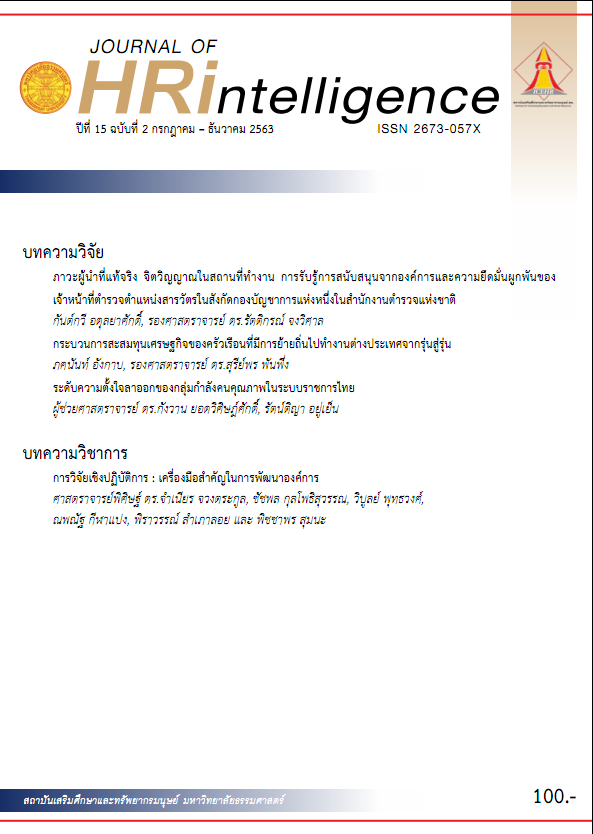ภาวะผู้นำที่แท้จริง จิตวิญญาณในสถานที่ทำงาน การรับรู้การสนับสนุนจากองค์การ และความยึดมั่นผูกพันของเจ้าหน้าที่ตำรวจตำแหน่งสารวัตร ในสังกัดกองบัญชาการแห่งหนึ่งในสำนักงานตำรวจแห่งชาติ
Main Article Content
บทคัดย่อ
การวิจัยครั้งนี้มีวัตถุประสงค์เพื่อศึกษา 1) ระดับภาวะผู้นำที่แท้จริง จิตวิญญาณในสถานที่ทำงาน การรับรู้การสนับสนุนจากองค์การ และความยึดมั่นผูกพันของพนักงาน 2) ความสัมพันธ์ระหว่างภาวะผู้นำที่แท้จริง
จิตวิญญาณในสถานที่ทำงาน การรับรู้การสนับสนุนจากองค์การกับความยึดมั่นผูกพันของพนักงาน และ
3) อิทธิพลของภาวะผู้นำที่แท้จริง จิตวิญญาณในสถานที่ทำงาน การรับรู้การสนับสนุนจากองค์การ ที่มีต่อ
ความยึดมั่นผูกพันของพนักงาน กลุ่มตัวอย่างที่ใช้ในการวิจัย คือ เจ้าหน้าที่ตำรวจตำแหน่งสารวัตรในสังกัดกองบัญชาการแห่งหนึ่งในสำนักงานตำรวจแห่งชาติ จำนวน 207 คน ใช้แบบสอบถามเป็นเครื่องมือในการเก็บข้อมูล โดยผลการวิจัยพบว่า 1) ระดับของภาวะผู้นำที่แท้จริงและความยึดมั่นผูกพันของพนักงานอยู่ในระดับค่อนข้างสูง ส่วนระดับจิตวิญญาณในสถานที่ทำงาน และการรับรู้การสนับสนุนจากองค์การอยู่ในระดับปานกลาง 2) ภาวะผู้นำที่แท้จริง และจิตวิญญาณในสถานที่ทำงานมีความสัมพันธ์ในทางบวกกับความยึดมั่นผูกพันของพนักงานอย่างมีนัยสำคัญทางสถิติที่ระดับ .01 ส่วนการรับรู้การสนับสนุนจากองค์การ มีความสัมพันธ์ในทางบวกกับความยึดมั่นผูกพันของพนักงานอย่างมีนัยสำคัญทางสถิติที่ระดับ .05 3) ภาวะผู้นำที่แท้จริงและจิตวิญญาณ
ในสถานที่ทำงาน สามารถร่วมกันพยากรณ์ความยึดมั่นผูกพันของพนักงานได้ อย่างมีนัยสำคัญทางสถิติที่ระดับ .001 โดยสามารถร่วมกันพยากรณ์ ได้ร้อยละ 15.1
Article Details
ขอมอบลิขสิทธิ์บทความที่ได้รับการตีพิมพ์ให้แก่สถาบันเสริมศึกษาและทรัพยากรมนุษย์ กรณีมีการฟ้องร้องเรื่องการละเมิดลิขสิทธิ์เกี่ยวกับภาพ กราฟ ข้อความส่วนใดส่วนหนึ่ง และ/หรือข้อคิดเห็นที่ปรากฎในบทความ ให้เป็นความรับผิดชอบของข้าพเจ้าและผู้เขียนร่วมแต่เพียงผู้เดียว
เอกสารอ้างอิง
Aon Hewitt. (2015). Re: Trends in Global Employee Engagement Making engagement happen. Retrieved on October 12, 2015 from http://www.aon.com/puertorico/attachments/recursos-humanos/Final%20Trends%20in%20Global%20Employee%20Engagement%20Report%202015%20.pdf
Banchong, W., Khruahong, T., Phatthanaviriyapisan, A., & Piman, S. (2015).Significant Factors of Employee Engagement Prediction. The Journal of Faculty of Applied Arts, 8(1), 21-31.
Baumruk, R., Gorman, B., & Gorman, R. E. (2006). Why managers are crucial to increasing engagement. Strategic HR Review, 5(2), 24-27.
Chongvisal, R. (2012a). Factors effecting job satisfaction and employee engagement. Kasetsart Journal Social Sciences, 33(2), 188-202.
Chongvisal, R. (2012b). Leadership, Workplace Spirituality, Job Performance and Good Corporate Governance. NIDA Development Journal, 52(1), 101-129.
Chongvisal, R. (2013). Leadership: Theories, Research, and Approaches to Development. Bangkok: Chulalongkorn University Printing House.
Chongvisal, R. (2018). Organizational Psychology. Bangkok: Chulalongkorn University Printing House.
Eastman, P. (2014). The bottom line of authentic leadership. Leadership Excellence, 31(4), 42.
EconNews. (2015). Re: Economic crime after entering AEC [Online News]. Retrieved from http://www.econnews.co.th/%E0%B8%AD%E0%B8%B2%E0%B8%8A%E0%B8%8D%E0%B8%B2%E0%B8%81%E0%B8%A3%E0%B8%A3%E0%B8%A1%E0%B8%97%E0%B8%B2%E0%B8%87%E0%B9%80%E0%B8%A8%E0%B8%A3%E0%B8%A9%E0%B8%90%E0%B8%81%E0%B8%B4%E0%B8%88-aec/
Eisenberger, R., Huntington, R., Hutchison, S. & Sowa, D. (1986). Perceived organizational support. Journal of Applied Psychology, 71(3), 500-507.
Eisenberger, R., Armeli, S., Rexwinkel, B., Lynch, P. D., & Rhoades, L. (2001). Reciprocation of Perceived Organizational Support. Journal of Applied Psychology, 86(1), 42-51.
Hassan, S., Hassan, M., & Shoaib, M. (2014). Measuring the impact of perceived organization support, psychological empowerment and rewards on employees’ satisfaction: testing the mediating impact of employee engagement. World Applied Sciences Journal, 30(5), 652-660.
Jurkiewicz, C. L., & Giacalone. R. A. (2004). A value framework for measuring the impact of workplace spirituality on organizational performance. Journal of Business Ethic, 49(2), 129-142.
Khuankaew, T. (2011). Relationship between perceived organizational justice, perceived organizational support and organizational citizenship behaviors of operational employees : a case study of an electronic components manufacturer. (Master’s thesis). Thammasat University, Bangkok.
Krejcie, R. V., & Morgan, D. W. (1970). Determining sample size for research activities. Educational and Psychological Measurement, 607-610.
Krishman, J., & Mary, V. S. (2012). Perceived organizational support – an overview on its antecedents and consequences. International Journal of Multidisciplinary Research, 2(4), 1-13.
Men, L.R. (2015). Employee engagement in relation to employee–organization relationships and internal reputation: effects of leadership communication. Public relations Journal, 9(2). Retrieved from http://www.prsa.org/Intelligence/PRJournal/Vol9/No2/
Northhouse, P. G. (2010). Leadership: Theory and practice. (5th ed.). California: SAGE Publications, Inc.
Policemuseum Parutsakawan Palace. (n.d.). Thai police history. Retrieved from https://saranitet.police.go.th/museum/?page_id=337
Ram, P., & Prabhakar, G. V. (2011). The role of employee engagement in work-related outcomes. Interdisciplinary Journal of Research in Business, 1(3), 47-61.
Rassmeethamchote, S. (2013). Employee Engagement in Practice. Bangkok: Eastern Printing Public Co., Ltd.
Rhoades, L., & Eisenberger, R. (2002). Perceived organizational support: A review of the literature. Journal of Applied Psychology, 87(4), 698-714.
Royal Thai Police. (2016). Royal Thai Police action plan B.E. 2559. Retrieved from http://www.strategypolice.com/webdatas/DraftPlan2559.pdf
Royal Thai Police. (2018). Royal Thai Police action plan B.E. 2561. Retrieved from https://www.royalthaipolice.go.th/downloads/plan61.pdf
Royal Thai Police. (n.d.). Vision. Retrieved from http://www.royalthaipolice.go.th/vision.php
Rubel, M. R. B., & Kee, D. M. H. (2013). Perceived support and employee performance: the mediating role of employee engagement. Life Science Journal, 10(4), 2557-2567.
Saengmukda, S., & Sumettikun, P. (2013) The Development of Authentic Leadership Measurement tools for Basic Education Institution Administrators. Journal of Education Studies, 41(3), 83-97.
Saenthong, N. (2005). Modern Human Resources Management in Practice. Bangkok: HR Center Co., Ltd.
Saks, A.M. (2006). Antecedents and consequences of employee engagement. Journal of Managerial Psychology, 21(7): 600-619.
Saks, A.M. (2011). Workplace spirituality and employee engagement. Journal of Management, Spirituality & Religion, 8(4), 317-340.
Suan, C. L., Mat, N., & Kandayah, J. A. (2011). Perceptions of authentic leadership and its impact on employee engagement: a case of Malaysia semiconductor manufacturing firm. Elixir International Journal, 41, 5871-5876.
Subramaniam, M., & Panchanatham, N. (2013). A study of spirituality in a public sector bank in India. International Journal of Advances in Management and Economics, 2(4), 102-113.
Sundaray, B. K. (2011). Employee Engagement: A Driver of Organizational Effectiveness. European Journal of Business and Management, 8(3), 53-59.
Suwanwet, S. (2006). Empolyee Engagement. Retrieved from www.pmat.or.th.
Vinitchainan, J. (2015, February 11). What's kind of effective tools for employee mindset measurement?. Posttoday, pp. B3.
Walumbwa, F. O., Avolio, B. J., Gardner, W. L., Wernsing, T. S., & Peterson, S. J. (2008). Authentic leadership: development and validation of a theory-based measure. Journal of Management, 34(1), 89-126.
Wang, D. S. & Hsieh, C. C. (2013). The effect of authentic leadership on employee trust and employee engagement. Social behavior and personality, 41(4), 613-624.
Wayne, S. J., Shore, L. M. & Liden, R. C. (1997). Perceived organizational support and leader-member exchange: A social exchange perspective. Academy of Management Journal, 40(1), 82-111.


